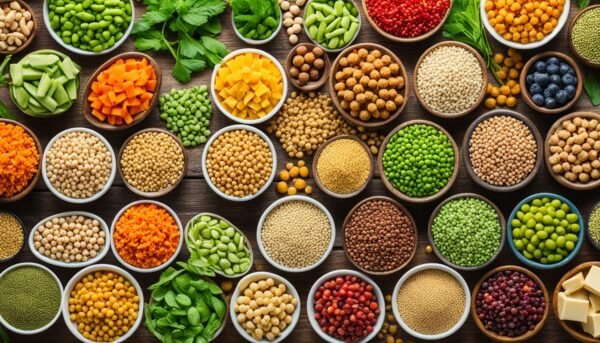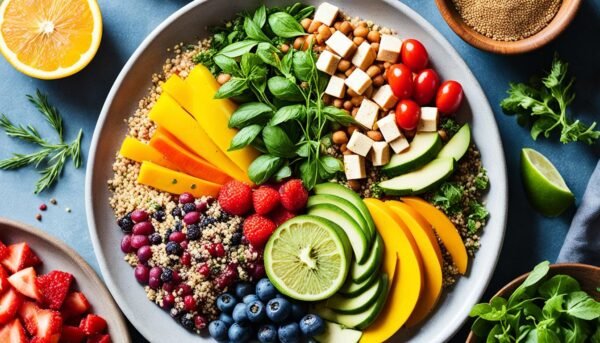Every bite we take on our journey toward health starts with a choice. This choice helps our bodies and protects the planet. It also shows respect for animals. In my cooking adventures, I’ve learned a lot about eating plants only. Many others feel the same after trying this way of eating.
Choosing plant-based foods is not just about what we don’t eat. It’s also about adding more green to our meals. Eating more plants might help us live longer. Let’s dive into the world of plant-based eating and the inspiring stories behind it.
Key Takeaways
- Adopting a plant-based diet can significantly benefit personal health and global sustainability.
- Vegan nutrition offers a wealth of diverse and delicious food options that cater to a variety of palates.
- Living a plant-based lifestyle is a profound step toward ethical consumption and animal welfare.
- Green eating is not only about what we eat, but also how our food choices impact the world around us.
- Through personal stories and evidence, we’ll see the transformative influence of plant-based diets on individuals’ lives.
What Is Plant-Based Nutrition and Why Is It Beneficial?
A whole-foods plant-based diet is more than just being vegetarian or vegan. It focuses on eating foods in their most natural form. This includes fruits, vegetables, seeds, nuts, and legumes. This way of eating is great for our health and vitality. It’s also key for sustainable eating and stopping diseases before they start.
Choosing to eat plant-based can lead to better health. Research shows it lowers the risk of high blood pressure, heart trouble, and diabetes. Alongside these health benefits, people find it easier to manage their weight. This happens naturally with this nutritious, high-fiber way of eating.
Eating plant-based is also better for our planet. It uses fewer of the earth’s resources than meat-heavy diets do. This means less greenhouse gases, and less water and land needed. It’s a big step towards ethical consumption. Every meal can help fight climate change.
This way of eating can transform not just our diets, but our health, and the planet. It has made me healthier and more connected to the world. Starting this journey helps prevent diseases. It means we are living by our promise to consume ethically.
Essential Nutrients in a Plant-Based Diet

Starting a plant-based diet brings up worry about nutrients, especially proteins and fats. Let’s clear up some myths and look at the nutrition from plants.
Protein Sources Without the Meat
Plant proteins can give you all the essential amino acids you need. Plants high in protein are plenty and taste great. Great protein sources are:
- Legumes like lentils and chickpeas
- Various nuts and seeds
- Soy products like tofu and tempeh
To get all amino acids, I mix plant proteins in meals. I combine grains like quinoa with legumes. Or I add nuts and seeds to salads or dishes.
Finding Your Vitamins in Vegetables and Fruits
Vegetables and fruits are key in a plant-based diet for their taste, vitamins, and antioxidants. Here’s how I get various essential micronutrients:
- Orange and yellow veggies for beta-carotene (turns into Vitamin A)
- Leafy greens for Vitamin K and iron
- Citrus fruits for lots of Vitamin C
Eating many colors every day makes sure you get enough nutrients. It also makes meals look good.
The Role of Healthy Fats in Plant-Based Eating
Healthy fats are important for hormones and absorbing vitamins. Good sources of plant fats are:
- Avocados, high in fiber and potassium too
- Nuts, with omega-3 fatty acids and protein
- Seeds like flaxseeds and chia seeds, rich in omega-3s
I try to include these fats every day, often with a morning smoothie. Adding ground flaxseeds or nuts boosts health. These little choices have big health benefits, giving energy and key nutrients.
Navigating Common Myths About Plant-Based Nutrition
I’ve seen many nutritional misconceptions on my plant-based journey. They stop many from seeing its benefits. It’s important to share true, well-researched info about plant-based eating. Let’s clear up some common myths.
Dispelling Vegan Myths: Some think vegan diets don’t have enough protein. But, there are many protein-rich plant foods like lentils, beans, tofu, and quinoa. Nuts and seeds are also great protein sources. You can get all the protein your body needs with these foods.
Plant-Based Health Facts: Another myth is about not getting enough calcium. But, many plant foods have calcium. Foods like broccoli, kale, almonds, and fortified plant milks are great for bones.
Some worry plant-based diets won’t keep you full. But foods high in fiber like whole grains, fruits, and veggies can be more filling. They also help with overall health.
Here are some stats and expert opinions to challenge vegan myths. They show the plant-based health facts:
| Nutrient | Plant-Based Sources |
|---|---|
| Protein | Lentils, tofu, chickpeas, quinoa |
| Calcium | Almonds, fortified plant milks, kale |
| Iron | Spinach, cashews, hemp seeds |
We can see that a well-planned vegan diet gives us all needed nutrients. Moving from myths to facts helps us choose diets that are healthy and based on science.
Plant-Based Nutrition Success: Tips and Recipes

Welcome to the journey of eating vegan in a healthy way. I’m here to give you some tips for balanced meals. These will make sure your food is good for your health.
Creating Balanced Plant-Based Meals
It’s important to know how to make vegan meals that are healthy. This means including a mix of proteins, fats, and carbs. Try to use many colors in your meals to get different nutrients.
Time-Saving Meal Prep for Plant-Based Eaters
Finding time for meal prep can be hard. Spending a few hours on the weekend helps. Cook a lot of grains, vegetables, and protein sources like lentils. This makes it easy to put together meals during the week.
- Chop and store vegetables in the fridge for up to a week.
- Pre-cook grains like quinoa and rice.
- Batch cook legumes and store them in the fridge or freezer.
Delicious Whole-Food Plant-Based Recipes to Get You Started
To enjoy healthy eating, try these easy yet nutritious recipes:
- Quinoa and Black Bean Salad: It’s tasty and can be a main dish or a side.
- Creamy Avocado Pasta with Cherry Tomatoes: It’s quick to make and full of healthy fats.
- Sweet Potato and Chickpea Buddha Bowl: This dish is balanced and looks beautiful, too.
With this advice and recipes, you’re all set to enjoy vegan meals. They’re good for you and easy to make, thanks to smart planning and a range of options.
Conclusion
Starting a plant-based life might feel tough, but it’s full of health and environmental perks. Going vegan is a big step towards living sustainably and consuming ethically. It’s good for you and the planet. To change what you eat, you need to learn, try, and be patient. I want to show you that moving to veganism is possible and worth it.
Choosing a plant-based diet introduces you to new tastes and health benefits. We’ve busted some myths and highlighted how plants offer proteins, vitamins, and good fats. With the recipes and tips given, you can make meals that are tasty and vegan. These suggestions aim to make adapting veganism easier in your daily life.
Deciding to eat more plants is a personal choice, but I hope this info makes you curious and confident. You can enjoy great food and help the planet too. As more people go plant-based, our combined impact on health and the environment grows. So, I urge you to think about the changes suggested here. Imagine the good you can do for yourself and others by choosing plants.
FAQ
What exactly is plant-based nutrition, and how does it differ from veganism?
Plant-based nutrition means eating foods mainly from plants. This includes fruits, veggies, nuts, seeds, and grains. It might have tiny amounts of animal products. Veganism avoids all animal products like dairy, eggs, and honey.
Can I get enough protein on a plant-based diet?
Yes, you can! Foods like legumes, tofu, lentils, and nuts have plenty of protein. It’s important to eat different kinds to get all the nutrients.
Are there any health benefits to eating a plant-based diet?
Sure, there are many benefits. Eating plant-based can lower the risk of many diseases. It’s good for your heart and can prevent diabetes and some cancers. Plus, it gives you more fiber, vitamins, and minerals.
Is it challenging to get enough vitamins and minerals on a plant-based diet?
Getting vitamins and minerals takes some planning but it’s doable. Eat plenty of fruits, veggies, grains, nuts, and seeds. Foods like dark greens and citrus are great for iron and vitamin C.
How can I ensure that I’m eating heart-healthy fats on a plant-based diet?
For heart-healthy fats, eat avocados, nuts, and seeds like chia. Use oils like olive and canola. These keep your heart strong and help your body use vitamins better.
What are some common myths about plant-based nutrition?
Some people think plant-based diets lack protein and nutrients. That’s not true. With the right foods, these diets are very nourishing and full of protein.
Do you have any tips for easy meal preparation for plant-based eaters?
A good tip is batch cooking. Cook big amounts of basics like grains and veggies once a week. Then, you can make quick meals anytime. Also, keep fruits and nuts ready for snacks.
Could you share an example of a balanced plant-based meal?
A great meal is a quinoa salad with beans, greens, tomatoes, avocado, and lemon-tahini dressing. It has everything – protein, fiber, healthy fats, and lots of vitamins.
Are plant-based diets environmentally sustainable?
Yes, they are better for the planet. They use less land, water, and energy. Plus, they cut down on greenhouse gases. So, they’re a greener choice.
How do I start transitioning to a plant-based nutrition?
Begin by adding more plants to your meals. Try replacing meat with plant proteins. Fill half your plate with veggies. Experimenting with recipes can also help.
This post may contain affiliate links which means I may receive a commission for purchases made through links. I will only recommend products that I have personally used! Learn more on my Private Policy page.